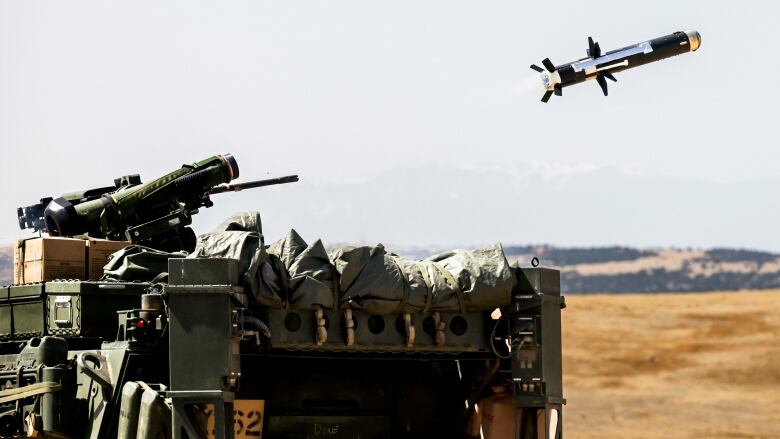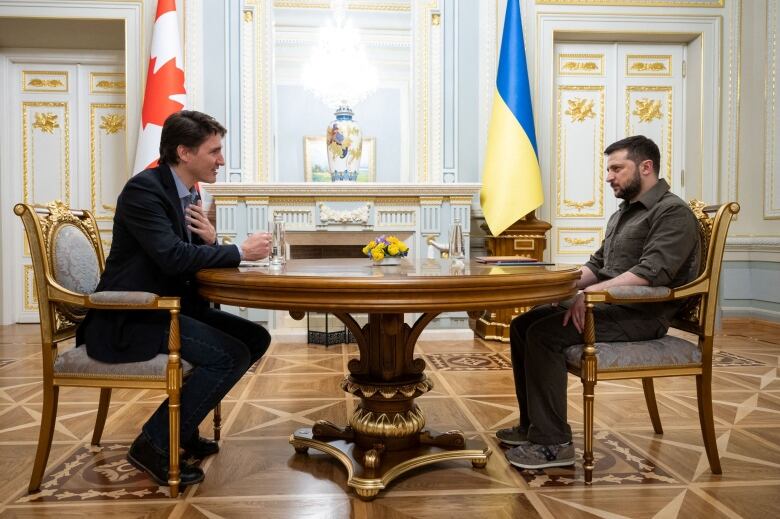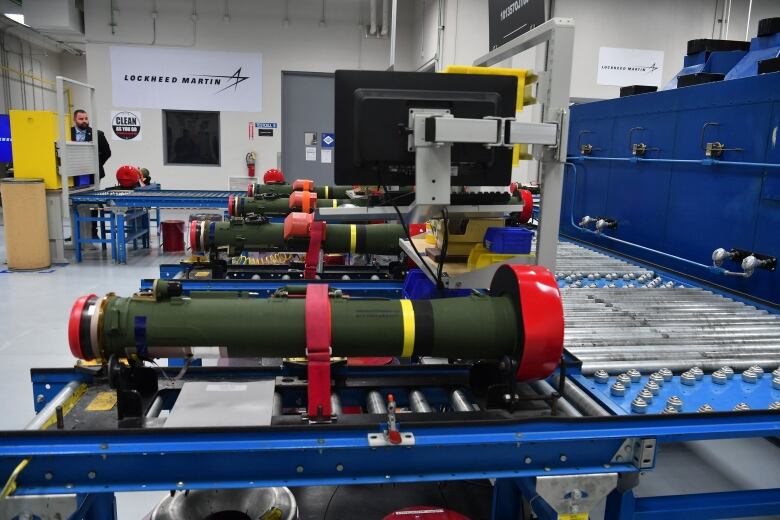Can the West continue arming Ukraine at the current rate?
If the West is in it for the long haul, defence contractors have work and hiring to do

Russian President Vladimir Putin did not pronounce any sort of victory or give indication that the fighting in Ukraine will end any time soon during the country's Victory Day Parade on Monday.
Later in the day,U.S.President Joe Biden said he was worried that Putin "doesn't have a way out" of the Ukraine invasion, another possible sign that a protracted struggle is in store.
For their part, Western leaders have said they are committed for the long haul in helping Ukraine fend off the Russian incursion.
But it will require a balancing act to continue supplying lethal aid, while not compromising domestic capabilities.
Canada: 'We can't mortgage the future'
Canada recently sent four of its relatively new M-777 howitzers to Ukraine's military. Prime Minister Justin Trudeau, during his visit to Kyiv on Sunday, announced more military aid that included artillery shells for those howitzers, additional drone cameras and small arms.
Canada previously sent thousands of M-72 rocket launchers, while announcing plans to purchase eight Roshel land-armoured vehicles for Ukraine,so as not to affect the Canadian Armed Forces inventory.

Gen. Wayne Eyre told CBC News Network's Power & Politics last week that Canada "can't mortgage the future," with an ever-shifting calculus going on in determining needs for its own high-readiness troops some 3,400 Canadian Forces members are on standby for NATO's Response Force while meeting those of troops already deployed and those in training.
To that end, Canada recently purchased from the Israeli company Rafael a small number of Spike anti-tank missiles for troops deployed in Iraq, CBC reported earlier this year, and the federal government has announced plans to buy 88 F-35 stealth fighter jets from Lockheed Martin.
Eyre said the defence industry needed to "go onto a wartime footing and increase their production lines to be able to support the requirements that are out there, whether it's ammunition, artillery, rockets, you name it." Ukrainian forces can't get too bogged down in "orphan" equipment not currently being serviced, he added.
With Arctic defence and NORAD among the non-Ukraine priorities, the Liberals last month announced a plan to boost defence spending by $8 billion over five years. Retired lieutenant-general and former Liberal MP Andrew Leslie, among others, has criticized the federal government for still falling short of a NATO commitment on defence spending.
On the flipside, while there may not be a lot of wiggle room for Canada to offer much more lethal aid right now, there is room to make more purchases like the Roshels. Canada ranks 25th out of 30 NATO members in terms of its military spending, according to a recent report from the alliance.
U.S.: Asked and answered
The U.S., by some estimates, has contributed over 70 per cent of all lethal aid going to Ukraine.
"In terms of the things that we will need most to maintain a ready defence against peer adversaries such as China and elsewhere, I think we're in pretty good shape," Mark Kimmitt, retired U.S. Army brigadier-general, recently told CBC's Power & Politics.
"Pretty good shape," was the exact phrase used by U.S. Secretary of Defence Lloyd Austin in congressional testimony last week, where he promised the Pentagon would not be going under"minimum required stockage levels" to meet its own purposes for addressing other potential global threats.
Pentagon spokesperson John Kirby said on May 6 that the U.S. has provided approximately $3.8 billion in security assistance to Ukraine since Russia invaded on Feb. 24.
The new ask from Joe Biden's administration from Congress included $20 billion in military assistance for Ukraine, NATO and domestic needs for replenishment. According to sources who spoke to Reuters on Monday, the administration may get that plus an additional $3.4 billion for Ukraine military aid.
The White House says it wants to see "additional artillery, armoured vehicles, anti-armour and anti-air capabilities flowing into Ukraine uninterrupted." Javelin anti-tank and Stinger anti-aircraft missiles are proving particularly popular in a battle "very dependent on long-range fires," Kirby said Monday.
Some lawmakers and analysts, including Kimmitt, believe the U.S. should invoke the Defense Production Act, legislation that came back into the parlance in 2020 when the pandemic required increased ventilator production.
Making missiles: How fast, how many?
Even if that act were invoked, boosting weapons production requires money, raw materials, qualified people for additional production lines and time.
The U.S. has sent about one-third of its Javelin stockpile and one-quarter of its Stinger stockpile to Ukraine, per an Associated Press report last week.
"Could this be a problem? The short answer is, 'probably yes,'" Mark Cancian, former government specialist on Pentagon procurement, told the AP.

Jim Taiclet, CEO of Lockheed Martin, told CBS's Face the Nation on Sunday that the company typically produces about 2,100 Javelins annually.
"We're endeavouring to take that up to 4,000 per year, and that will take a number of months, maybe even a couple of years to get there, because we have to get our supply chain to also crank up," he said.
The U.S. has also sent 1,400 Stinger missile systems to Ukraine. Bill LaPlante, who leads acquisition efforts for the U.S. Department of Defence (DoD), said on May 6 there is interest in meeting Ukraine's desire for more.But there's a catch.
"Unfortunately, DoD hasn't bought a Stinger in about 18 years, and some of the components are no longer commercially available," Raytheon CEO Greg Hayes said during a recent earnings call. "So we're going to have to go out and redesign some of the electronics in the missile and the seeker head. That's going to take us a little bit of time."
Pandemic slowdowns and illnesses have disrupted global supply chains for semiconductors, and the U.S. has hailed a number of initiatives since to ramp up domestic production of chips. That also will take time.
"There are 250 chips or more in every Javelin [missile] launching system," U.S. Commerce Secretary Gina Raimondo said on Capitol Hill late last month
How does the public feel?
Leaving aside weapons supply concerns, it appears that Trudeau and Biden in general are not facing greatopposition domestically when it comes to Ukraine aid.
In an Angus Reid survey of nearly 2,000 Canadians published on Monday, 38 per cent responded that Canada is not doing enough to support Ukraine, while 36 per cent indicated to the pollster that it's the right amount. Only 13 per cent said the level of support is too high.
A poll commissioned by the Washington Post and ABC News and published last week found nearly identical levels of support in the U.S. on similar questions.
Those kinds of surveys, of course, don't get into granular detail on Javelins, Stingers and howitzers.
But Trudeau, French President Emmanuel Macron and Germany's Olaf Scholzall had recent election wins. And the next U.S. presidential election is in 2024. Soseveral Western and G7 leaders don't seem to have a pressing worry on how their level of Ukraine military support will play out with the voters.
It remains to be seen if that holds if the fighting lingers and military spending continues to flow freely while Westerners feel months of pain on so-called kitchen table issues,like food and energy prices.
With files from Reuters and The Associated Press















_(720p).jpg)


 OFFICIAL HD MUSIC VIDEO.jpg)
.jpg)



























































































